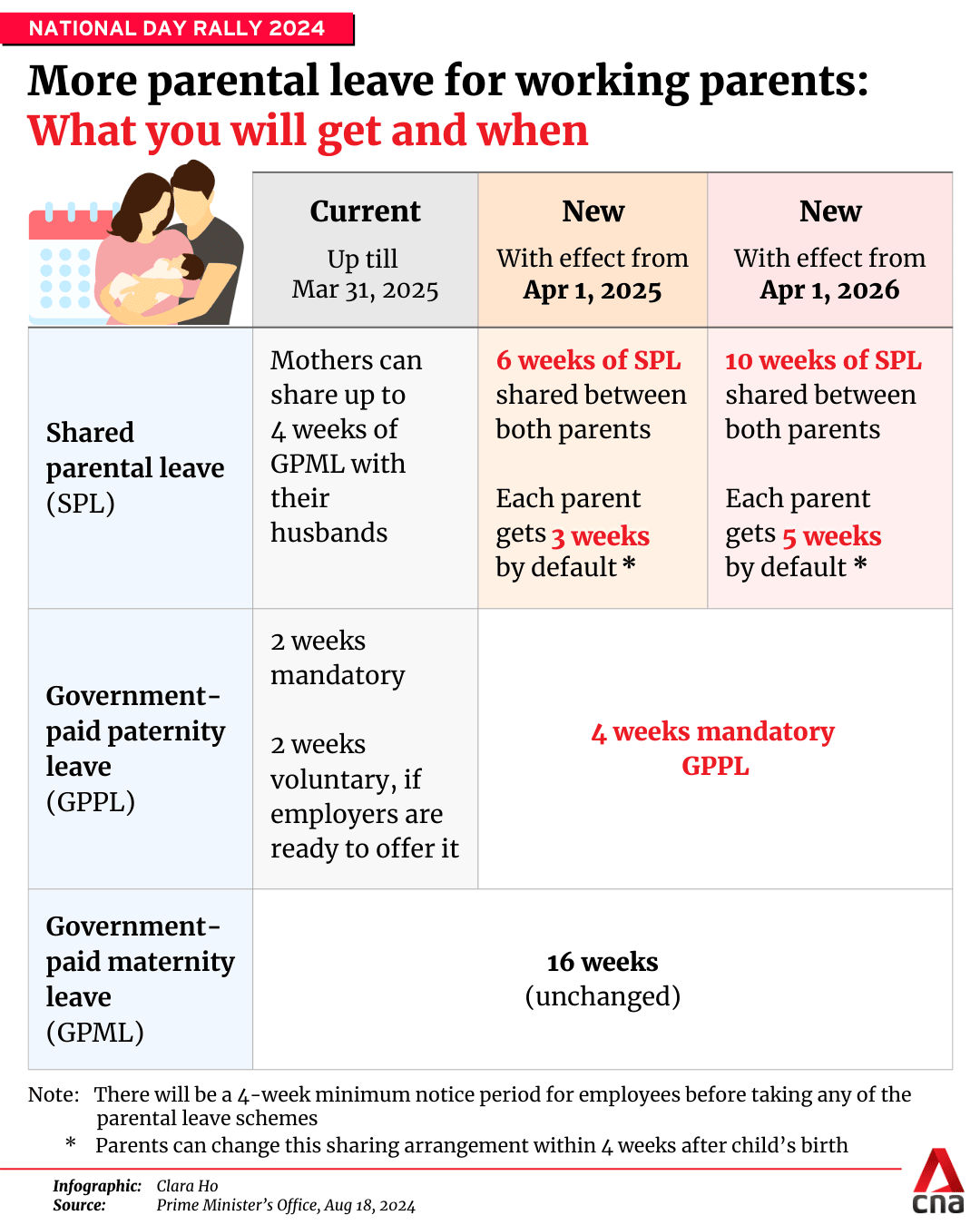FAQ: What you need to know about Singapore’s new shared parental leave scheme
When the scheme is fully implemented on Apr 1, 2026, parents will have a total of 30 weeks - about 7.5 months - of paid leave to spend with their infants.


This audio is generated by an AI tool.
SINGAPORE: A new shared parental leave scheme will give parents in Singapore 10 additional weeks of paid leave when fully implemented on Apr 1, 2026.
Announced by Prime Minister Lawrence Wong during the National Day Rally on Sunday (Aug 18), the scheme is part of the government’s efforts to give parents more time to care for their babies.
Here’s what you need to know.
WHAT'S THE SCHEME ABOUT?
The 10 weeks will be entirely paid for by the government, up to a cap of S$2,500 per week (up to ~S$10,000 a month).
It's on top of government-paid maternity and paternity leave entitlements.
It replaces an existing shared leave scheme, which allows a working mother to share with her husband up to four out of her 16 weeks of government-paid maternity leave. This will cease from Apr 1, 2025.
The new scheme will be rolled out in phases to manage the impact on employers, and give them time to adjust their operational and manpower arrangements.
When fully implemented on Apr 1, 2026, it will bring total paid leave to 30 weeks or 7.5 months, up from the current 20 weeks.
WHO'S ELIGIBLE?
Parents of Singaporean babies, including unwed mothers, according to the National Population and Talent Division (NPTD).
For fathers, only those legally married will be eligible.
Under the phased scheme, parents of babies born from Apr 1, 2025 will be eligible for six weeks of shared parental leave.
Parents will still qualify if their baby’s estimated date of delivery is from Apr 1, 2025 but the baby ends up born before that.
When the scheme is fully implemented on Apr 1, 2026, parents of newborn babies will be eligible for the full ten weeks of shared parental leave.

CAN ONE PARENT USE ALL THE SHARED LEAVE?
Yes. By default, the leave will be equally distributed between the two parents.
That's three weeks per parent for babies born between Apr 1, 2025 and Mar 31, 2026.
And five weeks per parent for babies born from Apr 1, 2026.
But NPTD said parents will have the flexibility to reallocate their leave, based on caregiving arrangement needs.
Parents can view their shared leave allocation and submit changes to the sharing arrangement within the first four weeks of their child’s birth, via the LifeSG app.
After these first four weeks, parents who wish to change their arrangement can only do so if their employers agree.
Employers can check their employees’ leave sharing arrangements via the Ministry of Social and Family Development’s government-paid leave schemes portal, from next Apr 1.

WHAT IF SUFFICIENT NOTICE ISN'T GIVEN?
The four-week window gives employers early notice of their employees' leave plans, to help facilitate covering arrangements, said NPTD.
Beyond that, if employers cannot make the necessary covering arrangements in time, they have the discretion to not grant leave that's requested without the sufficient notice.
Employers may ask parents to defer or adjust their leave plans.
WHAT ABOUT THE SELF-EMPLOYED, OR THOSE ON SHORT-TERM CONTRACTS?
Self-employed parents will be entitled to the new shared leave scheme, provided they meet the eligibility requirements stated above. They just have to submit claims through MSF's government-paid leave portal.
As for parents with irregular employment arrangements - such as short-term contract workers - they can enjoy parental leave benefits under a new Shared Parental Leave Benefit (SPB) scheme.
Eligible parents – those who worked 90 days in the last 12 months - can claim reimbursement from the government for time taken off work to care for their infants.
NPTD said more details on the reimbursement process for this SPB scheme will be released closer to the implementation date.

















